A few days ago I visited the shipyard in Waren at Lake Mueritz again to check building progress on my Omega 42. For the past few months nothing spectacular has happened – I´ve mentioned it before – due to external circumstances. A huge storm had devastated the southern Baltic Sea harbors with hundreds of boats damaged, the new season started with its usual turmoil of de-winterizing hundreds of boats and as such, the guys in the shipyard had been very stressed busily working the more urgent jobs. Launch of ALPHA therefore is postponed to next season, 2025. Nevertheless, some small steps had been taken anyways.

The whole „rough” joinery for the complete boat is done. All bulkheads are set, laminated and glued to the hull, except for the bathroom. The guys are starting to paint the wooden surfaces with the “Omega 42 White” that has been developed especially for this boat together with the supplier to have a strong white coverage but a slight “seethrough” effect which is meant to just barely make the grain of the wooden parts visible. In this, the guys have applied the first layer to all visible surfaces. Not very much to talk about, you might say, and you are right. But then something truly amazing happened …
Talking details
As usual, I sat down with Heiner Francke, boss of Mueritz Bootsservice and mastermind behind the Omega 42 project, to discuss some future details and parts he needs for the next steps of boatbuilding. For some reason I had a question regarding the true measurements of the berths in the yacht. He went to the big principle interior plans of the boat, took the measurements and told me. Standing in front of the plans, I – just casually and by the way – mentioned how beautiful I found these from an aesthetical standpoint. He agreed and said: “That was really tough work and cost me a lot to draw these …” Wait. Hold on. To draw the plans? You?
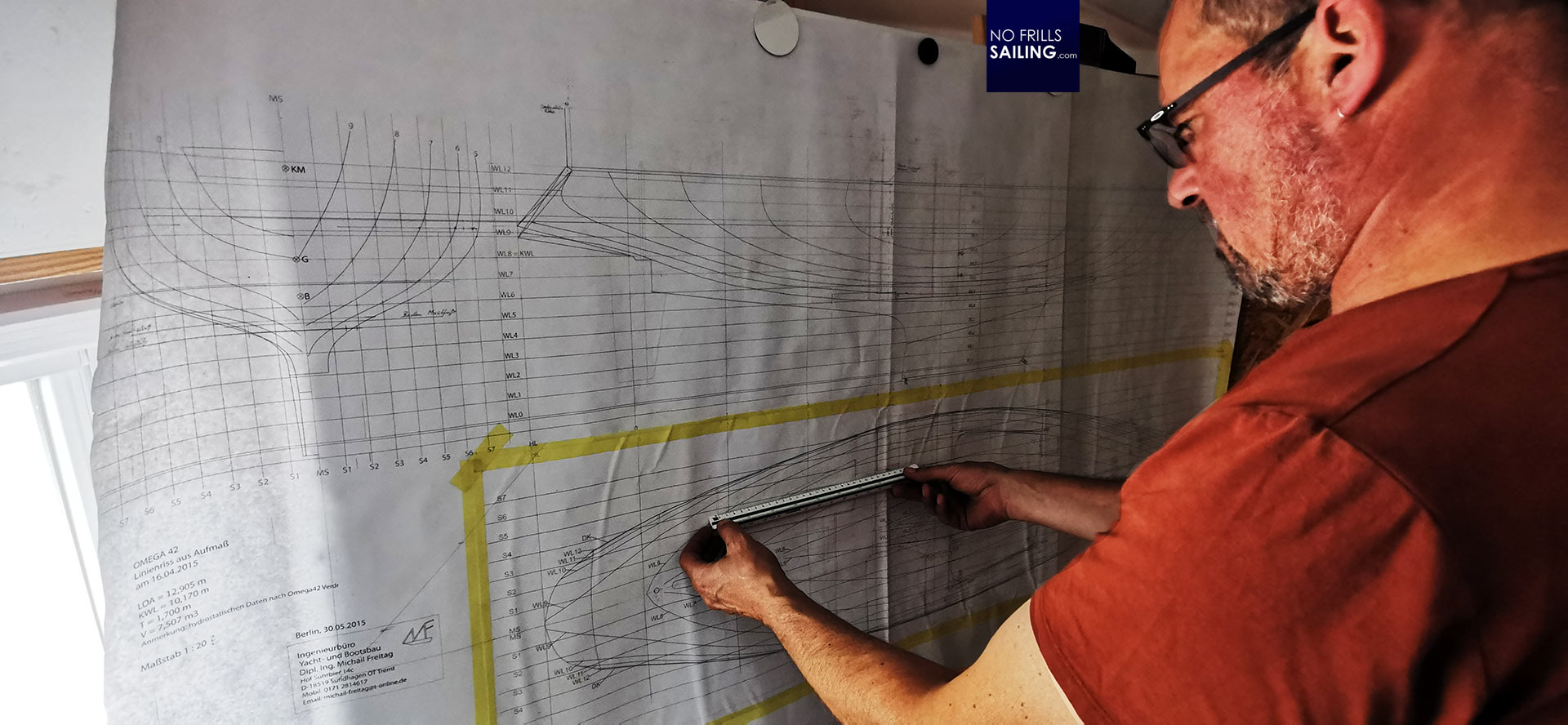
And this is when Heiner started to tell me the amazing story of acquiring the Omega 42 project and trying to gather as much information – real technical information – about the yacht as possible. “Making contact with the Norlin family is impossible.”, he says. “Apparently, all original plans, construction details and things a shipyard and boatbuilder needs to build this boat are gone. Either destroyed or just lost.” Every single plan, and before that, every single calculation, had to be reverse-engineered by Heiner in a meticulous and time consuming way. “We´ve managed to find a guy who possessed the original lamination manual of the Omega 42 though”, he tells me. Which at last is something, I replied. “Well”, Heiner said, “not so much. Just look at how they build boats back in the day … just a moment, I´m getting it for you.”
Historic: The lamination manual of the Omega 42
Heiner left the room and went to a storage in the garret. He came back with a ring file. Pretty worn down, a bit dusty. A blotchy note at the back stated a handwritten “Omega 42” and that was it. Multiple fingerprints done in various paints, glues, resins are put onto the black cardboard cover. It smelled old. “That is”, Heiner said with a slightly exaggerated ceremonial voice, “that is the original lamination guide of the last shipyard that was building the Omega 42.” And in this, he mentioned, that these are pretty much all of the original documents he was able to hunt down during the start phase of the project. Holy. Bible.

I started to flip through the pages. Surprisingly few of those. I had thought that this big thick ring file would be filled with hundreds of pages, detailed sketches, accurate depictions of details of the yacht. But I was about to be getting disappointed. There was just one really accurate construction drawing – but this one turned out to be a Peter Norlin original. Drawn by him in 1999 it showed the laminate thickness and number of layers to be put into the boat´s mould around the main frame of the boat. A truly spectacular document, I thought: A genuine hand drawn and handwritten Omega 42-plan by Norlin himself.
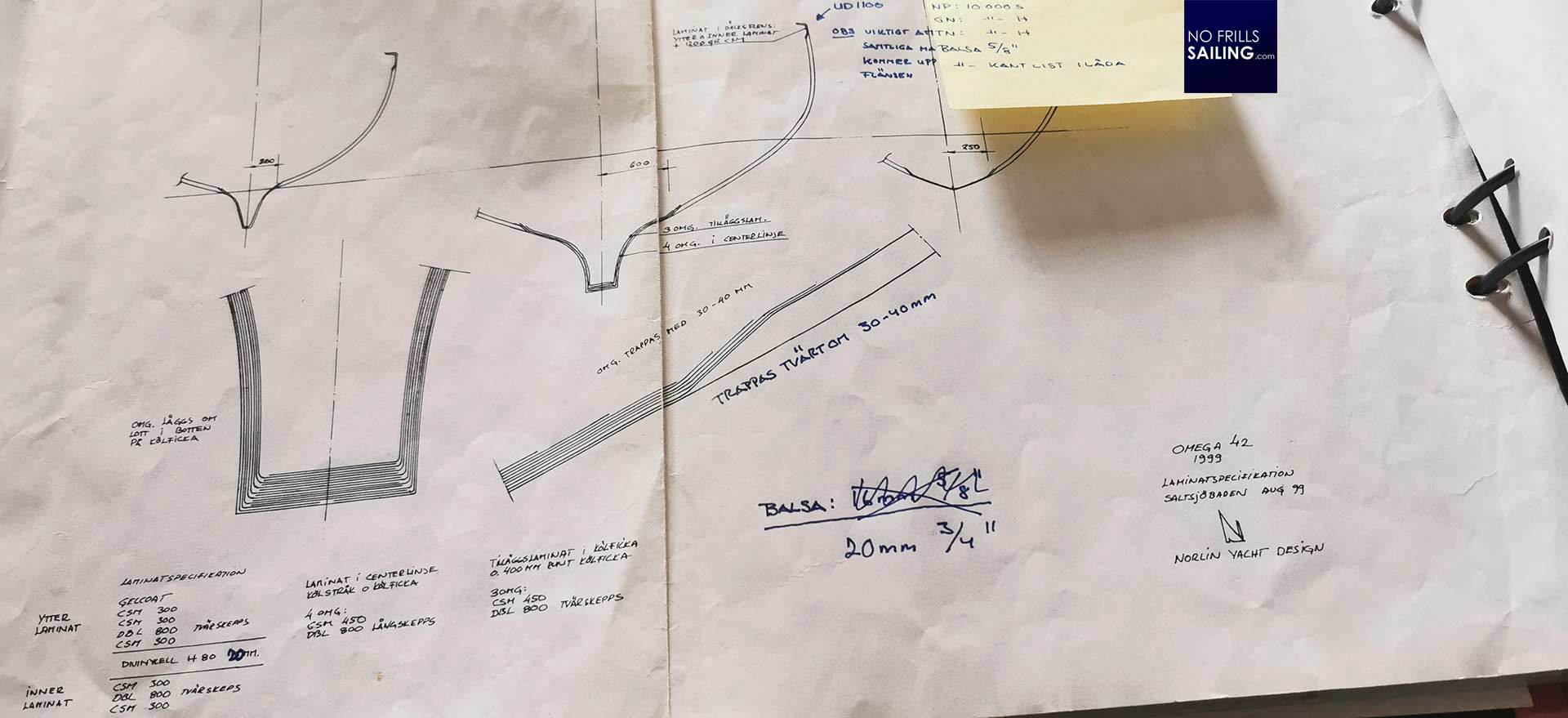
I admired the clean handwriting, the stroke of the pencil showing the laminate layers without a break or inconsistency. The plan shows some different areas of this particular cross section of the hull and gives guidelines for the number of layers and – I guess – in the part written down below the sketches, which garment sizes and strengths are to be used at which locations. The realization that Norlin even came up with those details, apart from creating the ship´s shape and ingenious lateral plan, is mind boggling to me. Unfortunately, this is the one and only real accurate plan of the “Lamination Bible”.
All is lost?
I´ve been to many, many shipyards in the course of the last eight years. Smaller manufactures which make barely 10 boats per year as well as to big brand mass production shipyards which produce highly industrialized cruising yachts. In this, lamination of hull and deck is a big thing and major component of making a boat. In each of those shipyards visited, I was able to take a look at the layup plans: The very guides used by the staff to get to know which glass fiber matt of which strength and garment type needs to be put in which direction at which location. These manuals or plans are highly sensitive materials, hence, no pictures allowed.
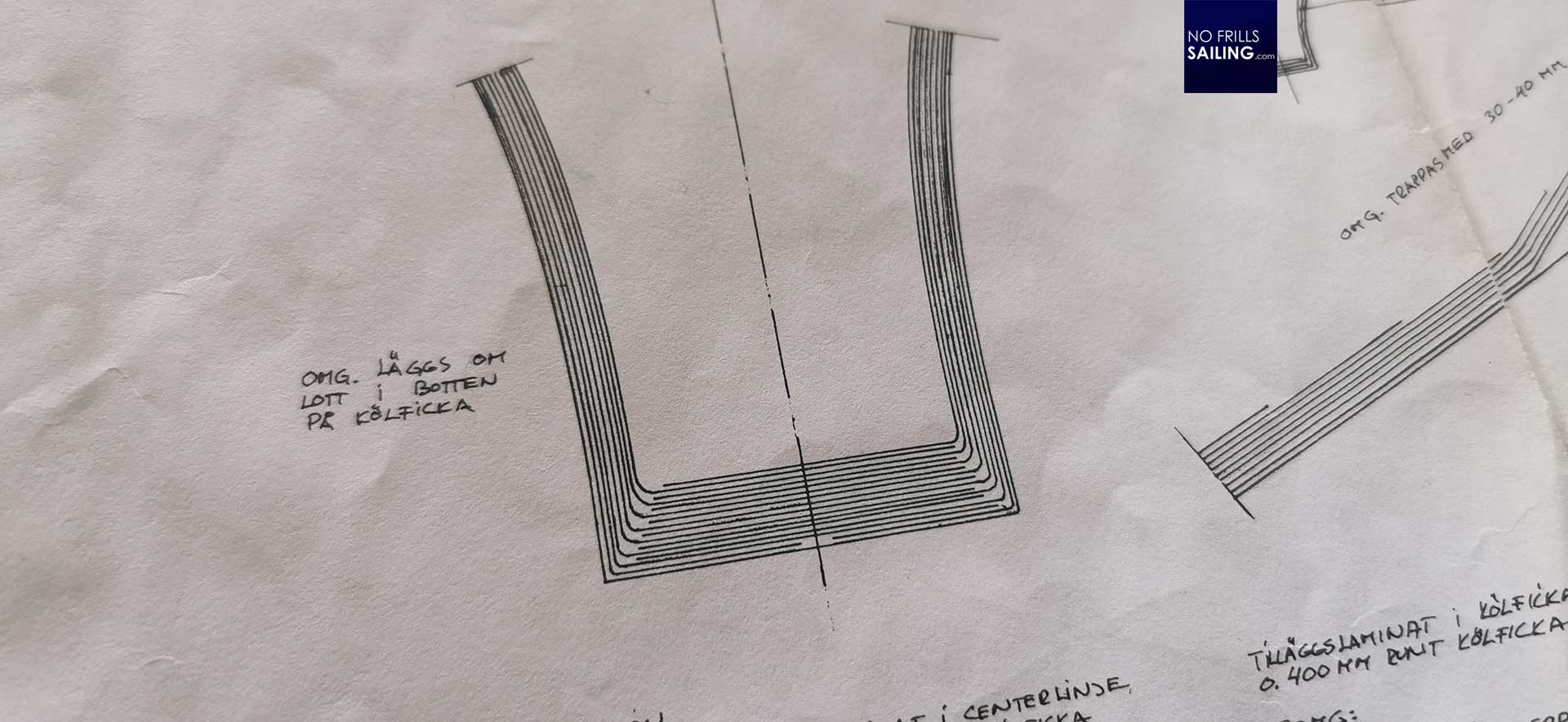
But I can assure you that these layup manuals are by far more accurate and specific than Peter Norlins rough 16-layer depiction of some keel-area of the Omega 42. I am puzzled. I ask Heiner Francke if this would have been all, and he confirms: “This is how they apparently built the boats back in the day. They just got the information of how many layers and which type – the location was pretty rough and there are no details whatsoever. The rest was knowledge, lots of experience and a deep understanding of GRP construction by the skilled people who did the job.” Amazing! And it gets even crazier the more pages I flip through …
Re-inventing the Omega 42
The original Omega 42 boats had been built with a partial Balsa sandwich core. I stop at a pretty amateurishly hand drawn sketch of the hull depicting the Balsa-areas of the hull. A loosely sketched drawing with some major measurements – merely a plan, more a memory aid. I just cannot imagine how the guys in the shipyard 30 years ago would start a new shift or a new boat – did they really gather over these sketches to being briefed?
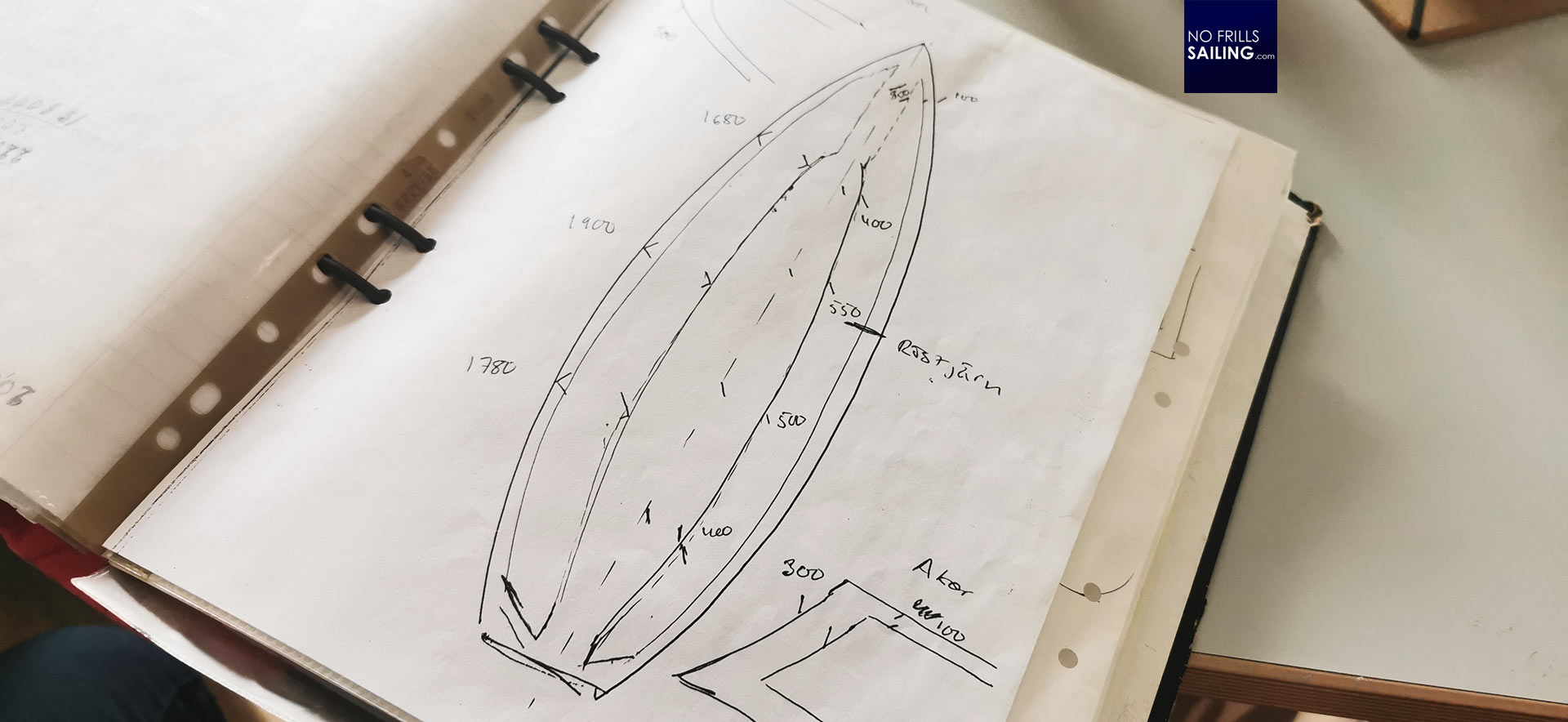
For the new, fourth generation, of Omega 42 which had being build at Swede Star shipyard at Lake Vänern in Sweden back in 2015 – hull #401 WINDFAENGER and hull #402 ALPHA (which is my boat) – the workers back then needed new instruction of how to do it. “I wanted to make the new Omega 42 in Peter Norlin´s legacy”, Heiner Francke tells me: “It means a lightweight, well balanced and absolutely powerful sailboat. I wanted to fully revive the ideas he had when he came up with this beautiful design. At the same time, I wanted to avoid the mistakes and – owing to the state of the art back in the day – technical mishaps of the yacht.” And so as apparently no real plans and details were available, he had to completely re-imagine, re-invent and re-calculate the boat from mast top to keel.
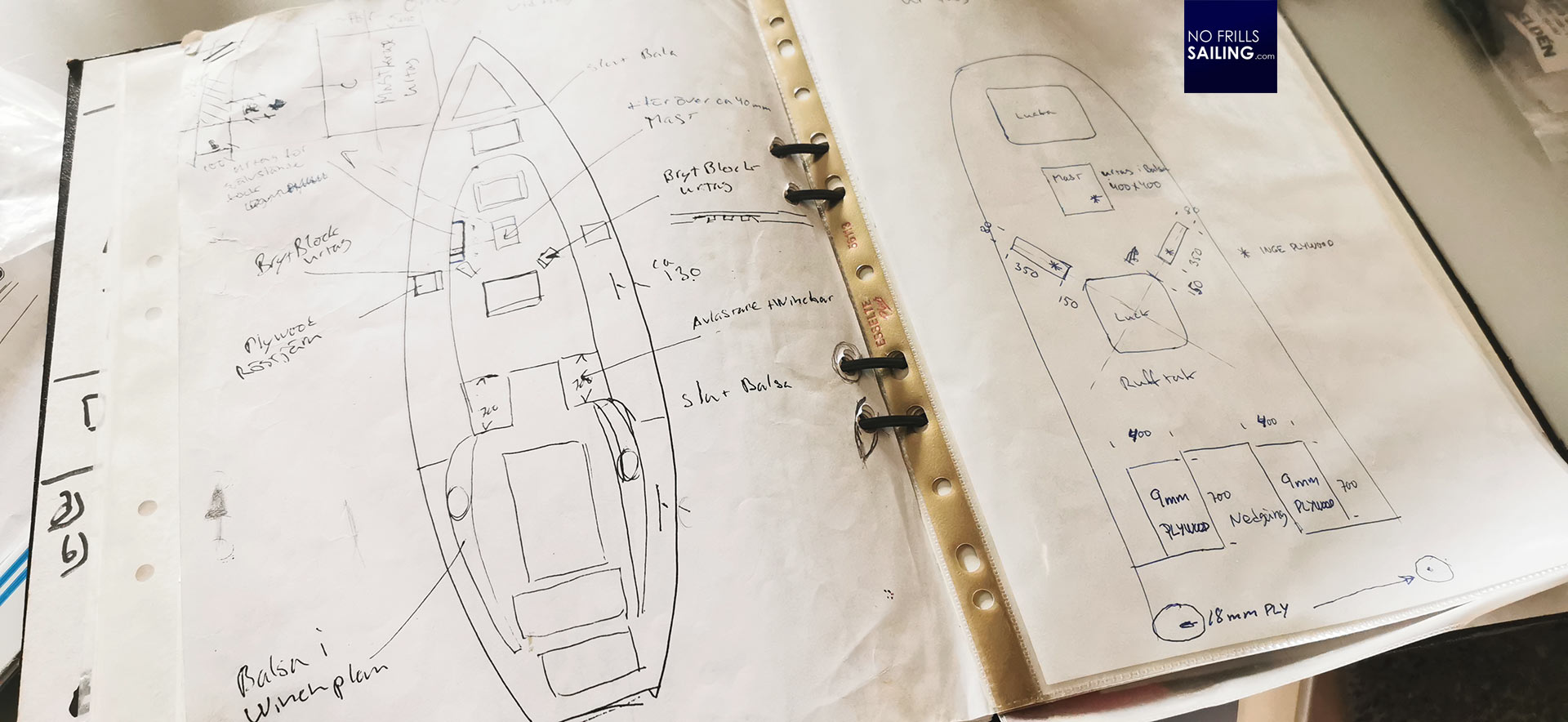
„Those sketches are – apart from the exciting historical value – really helpful to give directions and hints of how they had built the boats back in the day”, Heiner says. In this, skipping Balsa wood as the sandwich core material and utilizing modern synthetic core materials was one of the more easier tasks. Nevertheless, it took Heiner several trips to Sweden and investigative missions aboard dozens of classic Omega 42 yachts, crawling into all the hidden and far away corners of the boats, searching and measuring, even more crawling and even more reverse engineering to step by step build up an own set of data, ultimately cumulating in an own set of construction plans to even start the production of the new, 4th, generation of the Omega 42. “The sketches you see in that book are just the beginning of a long, long journey.”
Building the 4th generation of Omega 42 sailing yachts
Translating the original concept of Peter Norlin into a boat that is built with modern day materials – resins, glassfiber matts, synthetic core materials and so on – also meant that every single calculation regarding stiffness, structural integrity, material thickness and sizes, load and stress absorption and the whole rigging had to be done as if this was a new yacht. The thing is that the Omega 42 was constructed and built a long time before the boating industry had been made to follow CE regulations. Something very common and matter of course today – not apparent in 1979. “We want to sell these boats to clients, customers”, Heiner says: “And as a new build, of course, the Omega 42 needs a CE certificate.” But, apparently, you cannot give those sketches to the certifier …
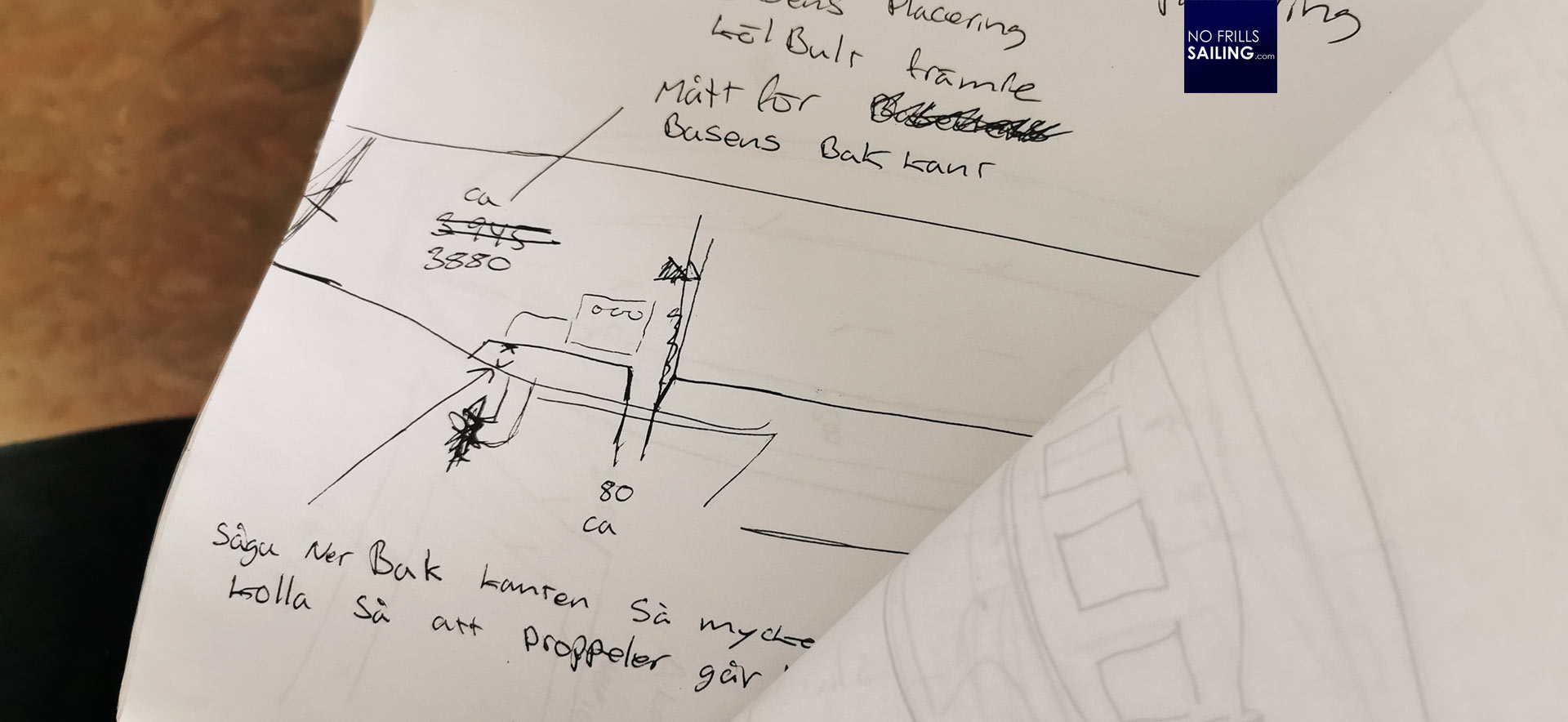
The Omega 42 is a true offshore-capable sailboat. She was imagined to win regattas in the Swedish archipelago – that is why her draft is so low and her mast is so high, to being able to sail closest possible to the little islands and stones to cut corners but also to being able to catch the wind going over those islands. But Omega 42 is also made to tackle the world´s oceans: Omega 42s are sailing in faraway areas as Australia – participating in hardcore races like Sydney-Hobart. This means: CE Category A. “Before being allowed to sell the new Omega 42 to owners, we had to go through CE-cetification process”, Heiner says and points to another ridiculous sketch, showing no less as the absolutely vital area of the keel-hull-connection: “Can you imagine the work?”
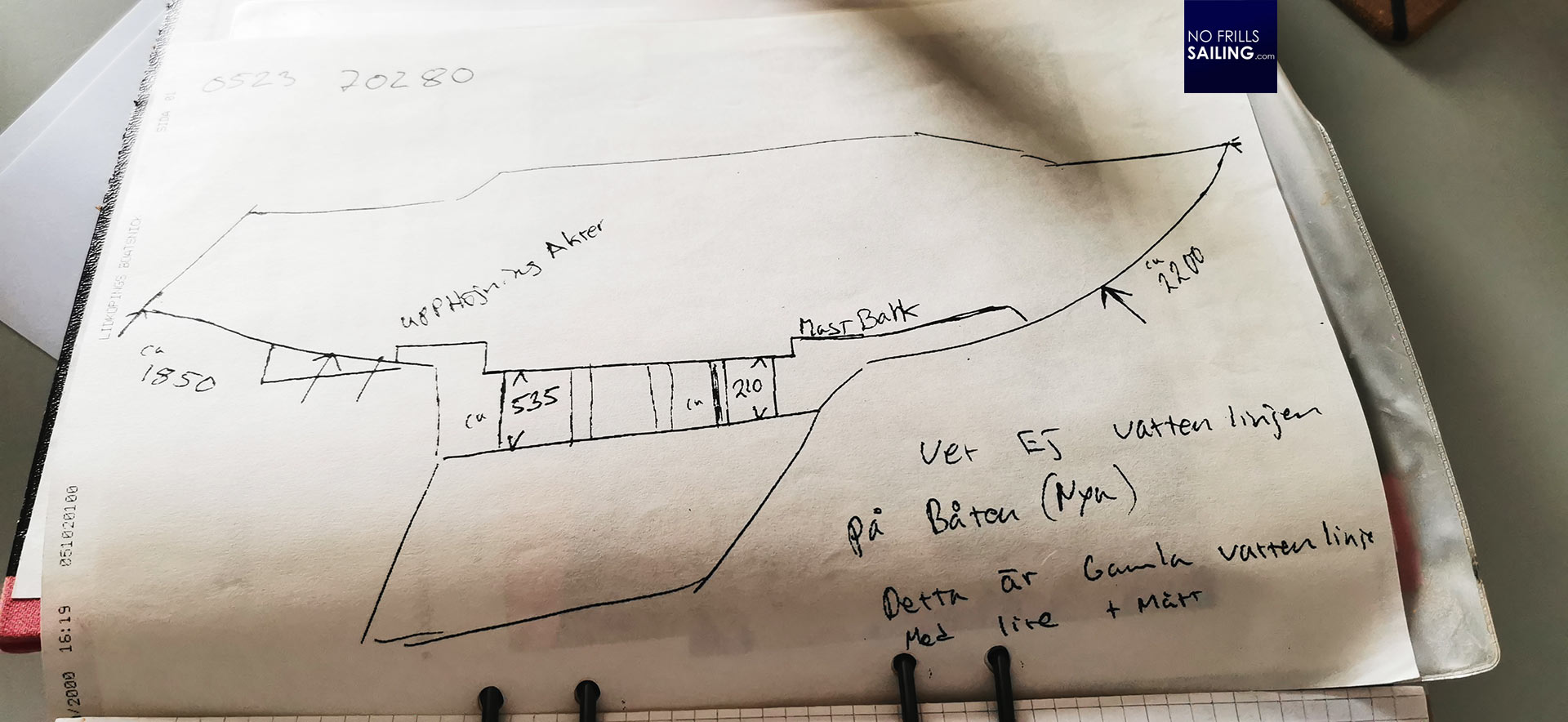
What usually takes a boatbuilder a few months, took almost two years for Omega 42 #410 WINDFAENGER. Normally, a shipyard will submit detailed CAD-plans of the boat where each and every detail is visible accurately with a few clicks. Apart from some few real-life tests, modern boat-constructions are certified “online”. Not so with our Omega 42. The CE-certification handler, a Swedish specialist, had to be flown in to certify after specific parts of the boat had been built. A painstaking process. Measurements, core drillings, tests and tests and tests. “I´d say that the CE-certification of the Omega 42 took almost triple the time and produced double the cost, if not more, than compared to a CAD-constructed modern yacht.” From the hand drawn sketches of the “Lamination Bible” to exact and CE-certified construction plans: What an amazing story!
When do you get your new Omega 42?
Knowing this, I am even more astonished and overwhelmed by the amount of work but more by the amount of love that goes into these boats. As a customer and future owner of my Omega 42 I am reassured that this boat is not just beautiful, lightweight and fast to sail but also safe and certified. Any new customer who decided to order one of these, #403, #404 and so on, will have the same reassurance that his classic boat is not just a sailing legend, but built according to present day safety standards. Back in the shed, the guys start to make the ship´s galley.
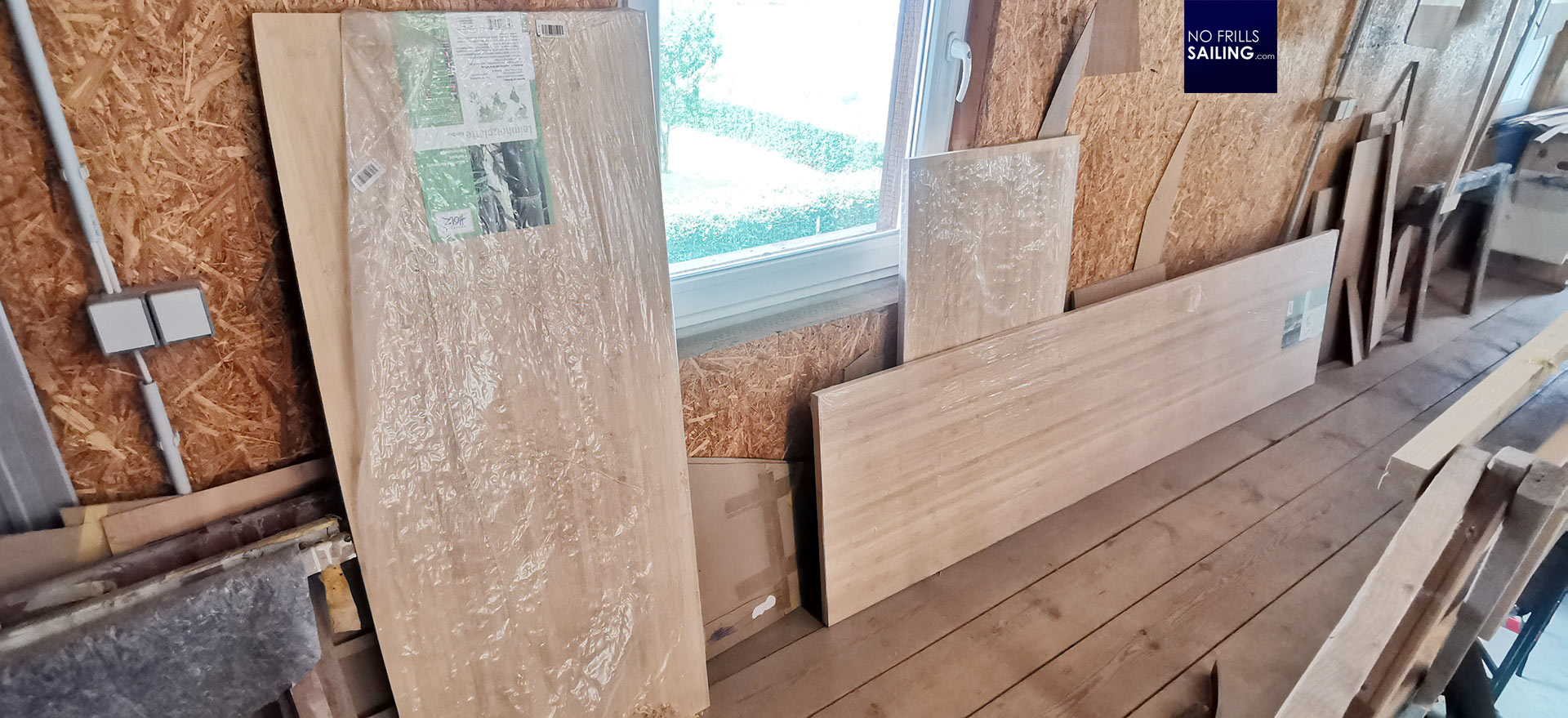
You may have read about my decision to opt for a spirits burning stove in my galley. I delivered this part to the guys, who showed me the status quo of the kitchen. Not all too much done, but at least the raw materials have arrived. Large thick – but very lightweight – boards of Bamboo have arrived. As I personally don´t like much the Corian “stone imitation” which has been used in #401 WINDFAENGER, we decided to use Bamboo. It´s very light weight (Heiner´s aim is to built ALPHA as the lightest ever Omega 42!) and has a nice kind of exotic look to it. I am sure it will look amazing down below as worktop in the galley and tabletop in the saloon.
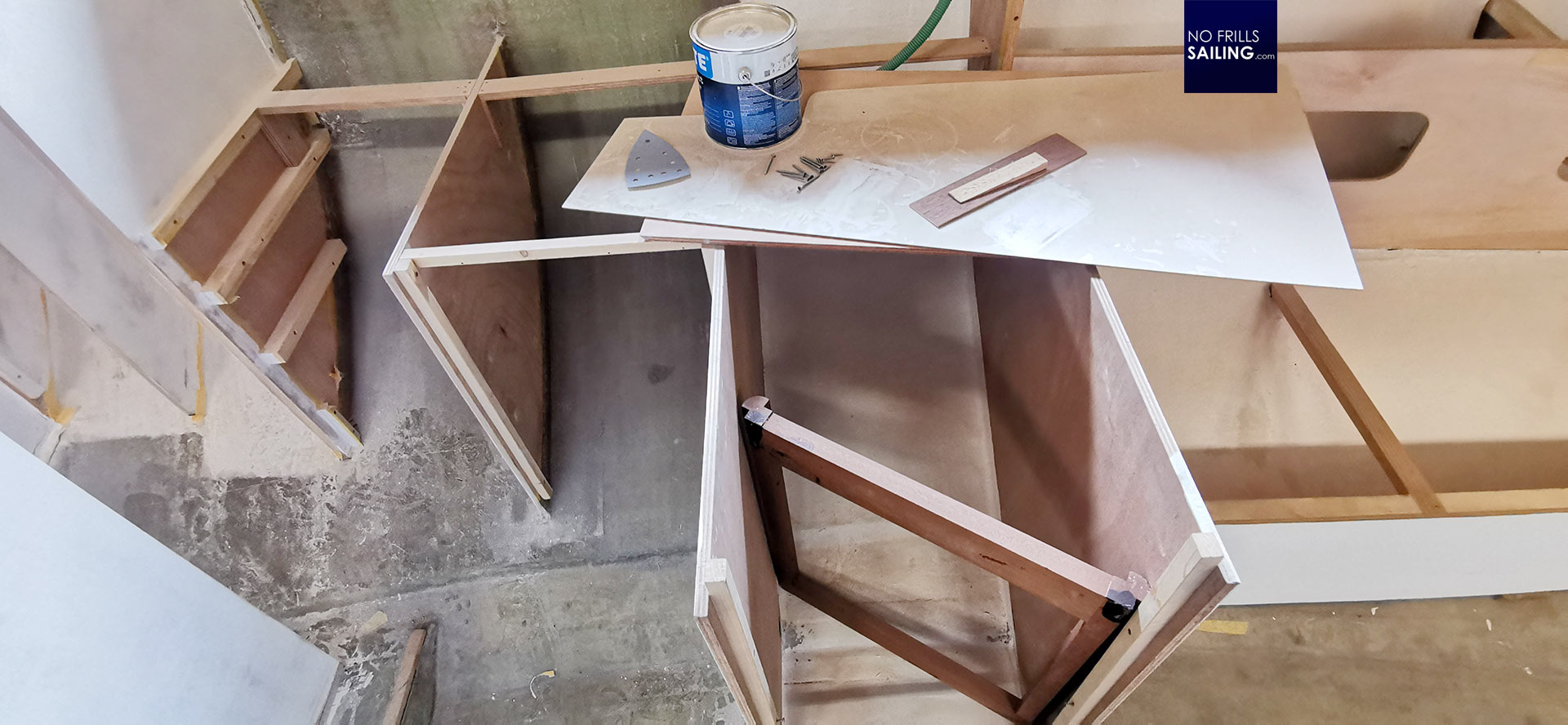
Now, this is not all too much of a building progress-article, but I thought that this story of the Lamination Bible and the rollercoaster ride to have the Omega 42 pass the tests and acquire her CE-category A certification was more than worth telling. Next progress-articles will follow, upcoming is the finishing and first onboard fitting of the new floorboards (part 1 here) and – something I absolutely look forward to! – the fitting of the Diesel-engine with saildrive fitting, cutting through the hull and so forth. Exciting weeks ahead – so stay tuned!
You may also like to read these related articles:
All building reports in chronological order
Who is Peter Norlin and why is he a legend?
Incredible: Sailing the Omega 42 for the first time
